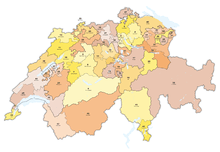1917 Swiss federal election
Federal elections were held in Switzerland on 28 October 1917. The Free Democratic Party retained its majority in the National Council.[1] They were the last elections held under the majoritarian system; following a referendum in 1918 in which two-thirds of voters voted for the introduction of proportional representation, the electoral system was changed and early elections held in 1919.
.svg.png) |
|---|
| This article is part of a series on the politics and government of Switzerland |
|
|

Electoral system
The 189 members of the National Council were elected in 49 single- and multi-member constituencies using a three-round system. Candidates had to receive a majority in the first or second round to be elected; if it went to a third round, only a plurality was required. Voters could cast as many votes as there were seats in their constituency.[2] There was one seat for every 20,000 citizens, with seats allocated to cantons in proportion to their population.[2]
Results
Voter turnout was highest in Schaffhausen (where voting was compulsory) at 86.8% and lowest in Uri at 23.4%.
| Party | Votes | % | Seats | +/– |
|---|---|---|---|---|
| Free Democratic Party | 210,323 | 40.8 | 103 | –9 |
| Social Democratic Party | 158,450 | 30.8 | 20 | +2 |
| Conservative People's Party | 84,784 | 16.4 | 42 | +5 |
| Liberal Democratic Party | 25,188 | 4.9 | 12 | –4 |
| Democratic Group | 16,818 | 3.3 | 7 | +3 |
| Party of Farmers, Traders and Independents | 19,459 | 3.8 | 4 | +3 |
| Other parties | 1 | +1 | ||
| Invalid/blank votes | 32,630 | – | – | – |
| Total | 547,652 | 100 | 189 | 0 |
| Registered voters/turnout | 915,552 | 59.8 | – | – |
| Source: Mackie & Rose,[3] BFS (seats) | ||||
References
- Elections to the National Council 1848–1917: Distribution of seats by party or political orientation Archived 2015-09-23 at the Wayback Machine BFS
- Dieter Nohlen & Philip Stöver (2010) Elections in Europe: A data handbook, p1886 ISBN 9783832956097
- Thomas T Mackie & Richard Rose (1991) The International Almanac of Electoral History, Macmillan